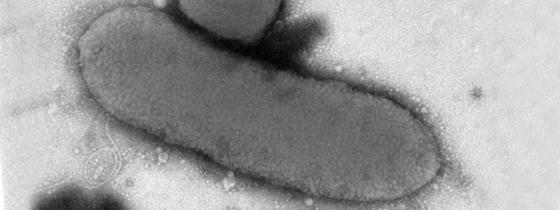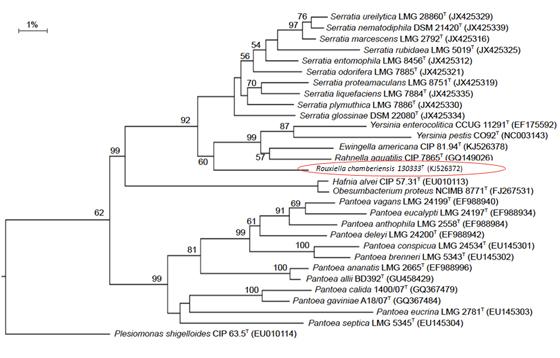Following the death of three newborns at Chambéry hospital (France) in December 2013, scientists at the Institut Pasteur quickly drew connections to a previously unknown bacterium responsible for the contamination of parenteral nutrition bags. Today, these scientists are publishing an article to announce the official recognition and complete characterization of this bacterium, which belongs to an entirely new genus. In homage to Emile Roux, a close collaborator of Louis Pasteur and head of the Institut Pasteur from 1904 to 1933, the bacterium was named Rouxiella chamberiensis. All of the data obtained through the sequencing and characterization of this bacterium have been made available to the wider scientific and medical community.
Press release
Paris, March 17, 2015

In December 2013, following the deaths of three extremely premature newborns and the infection of a fourth at Chambéry hospital in France, the Institut Pasteur Laboratory for Urgent Response to Biological Threats (CIBU), led by Jean-Claude Manuguerra, was urged to identify the bacterium found in large quantities in six parenteral nutrition bags used to feed the newborns. The scientists were able to conclude that a new bacterium, belonging to a previously undescribed genus – which is quite rare in itself –, was behind the incident.
Dubbed Rouxiella chamberiensis by researchers, the bacterium has since been fully sequenced and its entire genome characterized. Just recently, it received official recognition from the International Committee on Systematics of Prokaryotes. The results of this study are published in the leading scientific journal for taxonomic studies, the International Journal of Systematic and Evolutionary Microbiology.
The name given to the bacterium's genus pays homage to French physician, bacteriologist and immunologist Emile Roux who co-founded the Institut Pasteur alongside Louis Pasteur. The species name gives reference to Chambéry where the new bacterium first appeared.
Officially recognizing a new species, and in this case a new genus, of bacteria is a long process. The scientists had to prove that it was a new bacterium by distinguishing it from all previously known and genetically similar bacteria.
Using their expertise in the identification of complex pathogenic agents, and the analytical tools and sequencing techniques at their disposal, the scientists at the CIBU were able to characterize the entire genome of Rouxiella chamberiensis. This enabled them to reveal some of the bacterium's more distinguishing characteristics. These include, surprisingly, multiplying at 4°C, whereas most enterobacteriaceae are not capable of development at temperatures below 8°C. Moreover, the bacterium becomes latent and stops developing at 37°C.
The isolated bacterial strains, as well as all of the collected genomic data, have been made openly available to the scientific community at large.
Today, the scientists at the CIBU are continuing their investigations in collaboration with other Institut Pasteur teams and outside institutions. In particular, they are working to develop a test to specifically detect Rouxiella chamberiensis. The scientists are also lending their expertise to the legal investigation. This should help establish how the nutrition bags were contaminated as well as help scientists understand where this bacterium came from and identify its action mechanism.

Illustration: Bacterial phylogenetic tree. © Institut Pasteur
Banner image: Photo taken using transmission electron microscopy with negative staining. © Institut Pasteur
Source
Rouxiella chamberiensis gen. nov., sp. nov., a new Enterobacteriaceae isolated from parenteral nutrition bags, International Journal of Systematic and Evolutionary Microbiology, March 2015
Anne Le Flèche-Matéos1, Marion Levast2, Fabienne Lomprez1,Yolande Arnoux1, Clément Andonian2, Michel Perraud3, Véronique Vincent1,Meriadeg Ar Gouilh1,Jean-Michel Thiberge1, Mathias Vandenbogaert1,Laure Diancourt1, Valérie Caro1, Ana Maria Burguière1, Jean-Claude Manuguerra1
(1) Unité Environnement et Risques Infectieux, Cellule d’Intervention Biologique d’Urgence, Institut Pasteur, F-75724 Paris Cedex 15.
(2) Laboratoire de bactériologie, Centre Hospitalier de Chambéry, F-73011 Chambéry Cedex.
(3) Laboratoire de Biologie-Sécurité-Environnement, Centre Hospitalo-Universitaire de Lyon, F-69437 Lyon Cedex 03.


